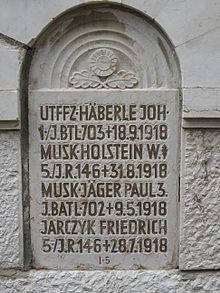German military cemetery in Nazareth
| graveyard | |
|---|---|
|
German war cemetery Nazareth |
|
| Country: | Israel |
| Region: | Nazareth |
| Place: | German military cemetery in Nazareth |
| Inauguration: | June 30, 1935 |
On the German cemetery in Nazareth in Israel 261 are German soldiers buried that in the First World War on the side of Germany with allied Ottoman Empire fought and on the Palestinian front in Palestine and Transjordan were killed.
The dead
War events
In the First World War, German-Turkish troops moved towards the Suez Canal from January 1915 , met British troops and continuously retreated on the Palestine front. Of the 16,000 German soldiers of many denominations (Calvinists, Jews, Catholics, Lutherans, United Protestants and Templars), including Germans from abroad recruited locally from among Palestinian Germans , 1,000 were killed.
Many of the soldiers who fell in Palestine and were buried in Nazareth were members of the Royal Bavarian Air Force . Their main task was the then new type of aerial reconnaissance against the British and rebel Arabs, as well as the defense against enemy aircraft - especially to protect the Hejaz Railway and the Maṣʿūdiyya – Sinai military railway - and the bombing of military targets. Accordingly, the German aircraft were less designed for aerial combat and at a disadvantage compared to the British.
After the abandonment of Jerusalem in December 1917, the headquarters of the German troops was in Nazareth until the city was captured by the British under General Allenby on September 20, 1918 .
Archives
The documents on the war dead in Berlin-Spandau in spring 1945 were destroyed by bombing . Norbert Schwake researched the data of the deceased from the Israeli State Archives Ginzach Hamedinah in Jerusalem, the Archives of the Foreign Office, the War Archives of the Bavarian Army in Munich and the Evangelical Central Archives in Berlin.
Access to the cemetery
Behind a locked gate lies the hospital brothers cemetery. From there a narrow staircase hidden by a tree leads to a terrace. Then walk through the terrace and through an open hall. Then up a flight of stairs.
The cemetery
The site of the cemetery is now in the area of the hospital of the "Holy Family" (also called the Italian hospital ).
The old hospital cemetery
During the First World War, the Holy Family Hospital of the Austrian Brothers of Mercy was used as the Imperial German Field Hospital 213. The 51 fallen soldiers were buried next to the hospital.
The collective cemetery
The building in its current form was built in 1934/35 according to plans by the chief architect of the Volksbund Robert Tischler and inaugurated on June 30, 1935. The German fallen in the British Mandate (Palestine and Transjordan) were transferred to a new collective cemetery, which was located near the old hospital cemetery. The old hospital cemetery was given to the Brothers of Mercy as a monastery cemetery. From 1937 the Austrian brothers took over the care of the graves. From 1959 this was done by the Italian brothers in the Milan province.
German War Graves Commission
After the establishment of diplomatic relations between Germany and Israel in 1965, repairs were carried out in 1967 and 1982. A symbol of peace is a tower with a large bell from Germany, in which wooden crosses made from propellers from crashed aircraft have been attached to the walls. About 250 dead rest in the cemetery. Each tombstone contains the name, the date of birth and death and the place of death. Memorial plaques remind of another 250 German and Austrian war dead who are not buried here. The Volksbund Deutsche Kriegsgräberfürsorge finances the maintenance of the cemetery and the monastery cemetery. Norbert Schwake, the former priest and former chief physician of geriatrics in the hospital of the Holy Family, does research on site and is involved.
International understanding
The cemetery is looked after by the Volksbund Deutsche Kriegsgräberfürsorge . A group of German volunteers and Israeli Chaverim (Hebrew: friends) from the handicapped village of Kfar Tikva also help with the gardening work .
Every year on Memorial Day , a memorial event for the German soldiers who died in Palestine and buried in Nazareth takes place at the invitation of the German embassy in Israel . Guests are mainly the military attachés from other countries who are accredited in Israel .
See also
literature
- Franz Hallbaum: German war cemetery Nazareth, Palestine. Built by the Volksbund Deutsche Kriegsgräberfürsorge eV In: Kriegsgräberfürsorge , Vol. 15 (1935), Issue 8, ISSN 0023-4648 .
- Norbert Schwake: German soldiers graves in Israel. The deployment of German soldiers on the Palestine front in the First World War and the fate of their graves . Aschendorff Verlag, Münster 2009, ISBN 978-3-402-00231-5 .
Web links
- Volksbund Deutsche Kriegsgräberfürsorge eV on the German Military Cemetery in Nazareth, accessed on July 7, 2012
- (en) German Military Cemetery, website of the Nazareth Cultural & Tourism Association
Individual evidence
- ↑ a b c Maurice Bonkat: Life and Death in Nazareth. In: Frieden, April 2014, pp. 10–13.
- ↑ Maurice Bonkat: Life and Death in Nazareth. In: Frieden, April 2014, pp. 10–13. (Description of the access by Norbert Schwake.)
- ^ Volksbund Deutsche Kriegsgräberfürsorge eV on the German Military Cemetery in Nazareth, accessed on July 7, 2012
- ^ Volksbund Deutsche Kriegsgräberfürsorge eV on the German Military Cemetery in Nazareth, accessed on July 7, 2012
- ↑ (en) German Military Cemetery, website of the Nazareth Cultural & Tourism Association
- ↑ Hans-Christian Rößler: Last resting place Israel . In: Frankfurter Allgemeine Zeitung of October 11, 2014, p. 3.
Coordinates: 32 ° 42 ′ 25.1 ″ N , 35 ° 19 ′ 8.1 ″ E




